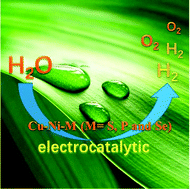Controllable synthesis of Cu–Ni–M (M = S, P and Se) hybrid nanoarrays for efficient water splitting reaction†
Abstract
Electrochemical water splitting has become one of the state of the art approaches to generate hydrogen. It is important to exploit relatively low toxicity, low cost and environmentally friendly water splitting electrocatalysts. A series of Cu–Ni–M (M = S, P and Se) materials were firstly in situ grown on Ni foam and these materials showed excellent water splitting activity. The Cu–Ni–S material shows excellent oxygen evolution reaction performance (200 mV@20 mA cm−2) and the Cu–Ni–P sample shows an effective hydrogen evolution reaction performance (52 mV@10 mA cm−2). When the Cu–Ni–S and Cu–Ni–P materials were assembled into a two-electrode system, the Cu–Ni–S/NF//Cu–Ni–P/NF electrode pairs display superior water splitting activity (1.50 V@20 mA cm−2), which is one of the best electrocatalytic activities reported so far. The experimental analysis demonstrates that the excellent performance of the Cu–Ni–S/NF and Cu–Ni–P/NF materials is attributed to the rapid electron transfer rate, increased electrocatalytically active area, more exposure to active sites and the superior synergistic catalytic factor of Ni2+ and Cu2+. It was found that amorphous oxides were in situ generated on the outside surface of the catalyst through the analysis of the catalyst after the reaction, and they were the real electrocatalytically active centers. Density functional theory demonstrates that the in situ generated Cu-doped NiOOH shows the optimal water adsorption energy compared with NiOOH. This work offers novel views for the design of relatively low toxicity, stable and inexpensive water splitting electrocatalysts.



 Please wait while we load your content...
Please wait while we load your content...